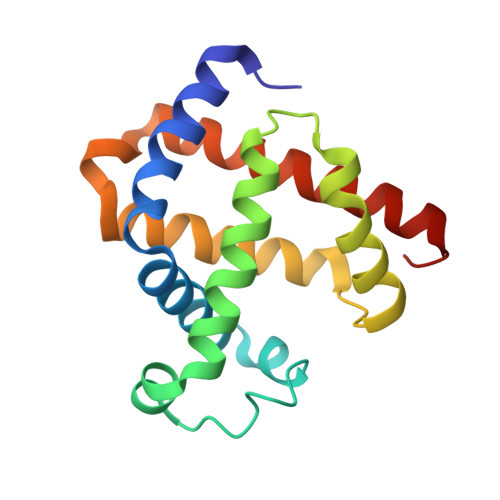Trans-substitution of the proximal hydrogen bond in myoglobin: I. Structural consequences of hydrogen bond deletion.
Barrick, D., Dahlquist, F.W.(2000) Proteins 39: 278-290
- PubMed: 10813811
- DOI: https://doi.org/10.1002/(sici)1097-0134(20000601)39:4<278::aid-prot20>3.0.co;2-t
- Primary Citation of Related Structures:
1DTM, 1DUK, 1DUO - PubMed Abstract:
The structural role of a side-chain to side-chain protein hydrogen bond is examined using trans-substitution of the proximal histidine of myoglobin with methylimidazoles (Barrick, Biochemistry 1994;33:6546-6554). Modification of the chemical structure of exogenous ligands allows this hydrogen bond to be disrupted. Comparison of the crystal structures of H93G myoglobin complexed 4-methylimidazole (4meimd; methylation at carbon 4) and 1-methylimidazole (1meimd; methylation at the adjacent nitrogen, preventing hydrogen bonding between the imidazole ligand and the protein) shows that the polypeptide, heme, and methylimidazole orientations are the same within error. For 4meimd there appear to be major and minor conformations corresponding to different tautomeric states of the ligand. Conformational heterogeneity is also seen in the hyperfine-shifted region of the NMR spectrum of 4meimd complexed with high-spin H93G deoxyMb. The major conformation of the 4meimd ligand and the 1meimd ligand, as seen in the respective crystal structures, are quite similar except that the proximal ligand NH-to-Ser92-OH hydrogen bond is eliminated in the 1meimd complex, and instead the proximal ligand CH is adjacent to the Ser92-OH. Thus, this system provides a means to eliminate the Mb proximal hydrogen bond in a chemically and structurally conservative way.
Organizational Affiliation:
The T.C. Jenkins Department of Biophysics, Johns Hopkins University, Baltimore, Maryland 21218, USA. [email protected]
















